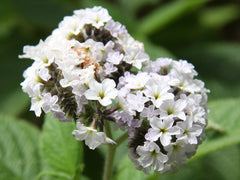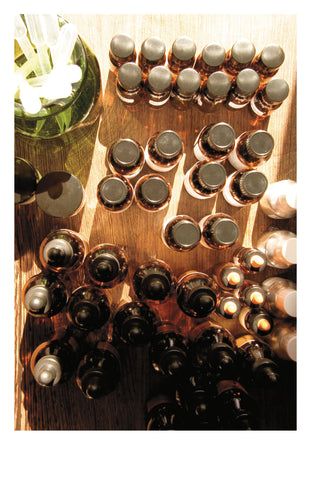In conversation with Ineke Rühland (Part II)

In Part I of our conversation with Ineke Rühland, author of After My Own Heart (Olfactif May 2013), she discussed her childhood and early career, training at the elbow of some of today's most famous perfumers, and how her non-perfume professional background helped her to launch her own line.
Olfactif: What brought you to San Francisco?
IR: I met my husband, who’s an American, in France, and then he got transferred to San Francisco in 2000. Those were weird years in San Francisco. I loved it, but you’d go in a coffee shop and you’d see people taking meetings with venture capitalists and it all felt so “gold rush” in terms of technology. Just a year later, there was the big dot-com crash, and so things felt really depressed for quite a few years afterwards.
O: What is San Francisco like for you now?
IR: People here are so positive, which was such a breath of fresh air. And I just love the weather here. I even don’t mind the fog and the coolness in the summer, and even right now as I’m sitting here I see the fog rolling overhead. The sky here is usually so bright and blue, and generally we don’t have clouds or rain all summer. I remember waking up every morning after moving here and feeling so privileged to be here. I had this honeymoon that lasted at least a year, and I had the feeling of waking up every day with this little joy in my heart like, “Ah, it’s such a great city.” To this day I still really like San Francisco. It has a really high quality of life.
 O: You have a house there?
O: You have a house there?
IR: We have a little house and a scented garden. There’s always something scented in bloom. Right now, we have a scented rhododendron and there’s a clematis, which is a vine, that’s just starting to bloom. We have a magnolia grandiflorum that has a flower right now, a huge flower, and we have lots of roses—maybe eight different rose bushes. We have lilac, jasmine, wisteria, osmanthus, boronia, daphne, heliotrope, gardenia. I would say 50 different scented things.
O: When you decided to come to San Francisco, did you know you were going to start your own line?
IR: No. I started to see some niche brands being successful, and that gave me the idea. It’s so entrepreneurial here in San Francisco, and I started to see that there could be some possibilities in the market for niche brands. I really started to think about it in 2002, 2003, and I launched the first scent in 2006.
O: Did you come up with the alphabet concept before you got started?
IR: Yes. In the very early days I was thinking up different concepts and came up with this idea for the alphabet. First of all, it’s a great organizing technique. It gives the line chronology so people will always know what the latest one is. And I think that the alphabet can be really nice graphically and it seems to act like a literary component.

O: A, for After My Own Heart, is the first in your line and the one we’re featuring in May 2013. Can you tell me about the birth of this fragrance?
IR: I love lilac—that’s a Canadian thing. We had a lilac bush, and it’s one of the very first scented flowers that I can remember. I remember even in kindergarten bringing cut lilac branches to my teacher, like it was this amazing offering or something. But I just loved the smell of lilac always. Lilac hasn’t been played very often in perfume. So I just studied lilac accords and had this idea of making a really pretty, powdery lilac, but really fresh and green on top. That’s essentially what After My Own Heart is. I wanted to make it a soliflore so it would smell like lilac from beginning to end—a soft kind of lilac that is airy but still has character. It’s a simple idea but it’s always been one of the best sellers in my line.
O: And the dry down is so wonderfully warm and musky.
IR: Yeah, it is. It has heliotrope and musk, and a little bit of vanilla.
O: What role does the sandalwood play here?
IR: For me, sandalwood is the most feminine of the woods and it has a creaminess. So it gives the fragrance depth and warmth. The lilac starts off really green, and it could have been too cold and crisp without that sandalwood note.
O: What’s it like when people contact you and tell you what your fragrances mean to them?
IR: I love that, and I’m always amazed at how the fragrances mean such different things to different people. Maybe that’s an obvious thing to say, but people have such different scent references based on their personal histories. Even basic biology—olfactory receptors are not the same for everybody. People smell things differently. So people will come up with really specific attributes for my fragrances that I would never have thought of, but it makes me really happy that it works for them and that my fragrances can be universal enough that people can identify with them.
O: I read somewhere that you don’t think you’re very sentimental. Are any of your fragrances rooted in the past for you or is everything tied to the present?
IR: Oh, definitely, there are roots in the past. It’s funny that I said that because I think I’ve changed a little bit over time. I remember studying at ISIPCA, and the professors would always bring up the old fragrances stored in the cellar. We had one whole course on the history of fragrance, but even when we were creating structures the professors would go down and pick up all the historical structures. So if we were studying eau de colognes they’d go down and pick up Jean-Marie Farina from the 1700s, Eau Sauvage, and all of those big eau de cologne structures from over the years. But then when we would get to the more modern ones, I would always think, “Ah, that smells so much better.” I think we have so many more raw materials than we used to and there are so many more options now than there used to be. But I did end up creating some fragrances in recent years that are really vintage but mixed in a more modern way.
 O: Are there any notes that you find particularly joyful to work with or anything that’s really challenging to work with?
O: Are there any notes that you find particularly joyful to work with or anything that’s really challenging to work with?
IR: I think every perfumer has a palette of favorite materials. I have on my workbench over 500 different materials, and I probably, on a regular basis, use 50 of them. So there will be other materials that I may have used once or not at all, and I like having them as an option. I can’t imagine ever making a fragrance without hedione. It doesn’t smell like very much at all but it’s this incredibly pleasant floralizer. If you added hedione to a heavier note you would just get a fresher note. And so if you add hedione to rose absolute you get something much closer to the scent of the real rose. And then I can’t imagine ever making a fragrance without musk. I have probably 20 musks and I always use a musk cocktail of about three or four musks, and I try to make it a little different each time.
O: If you had to describe your style, could you? What would that be?
IR: I have that classical training and so I think about the technical structures and I try to balance the top notes and the middle notes and the base notes. I try to make sure that a fragrance doesn’t fall off a cliff—start off one thing and turn into something completely different. I think about transition. I don’t have a very heavy hand, and so I tend to be probably a little bit lighter and fresher than the average niche perfumer. I also like things pretty blended, so I don’t like to have really discordant notes. I tend to blend until things feel like a whole entity rather than having jagged notes sticking out.
O: You have a lot of insight into how the big fragrance companies work. How is your process different and how does it lead to a different result?
IR: The really big difference is that I am basically one person making the whole process from start to end—not just the fragrance but all the packaging ideas and the marketing. So it ends up being a pretty cohesive product. It doesn’t have the financial backing of what they would do, or the reach or all of the resources that a big company puts into a product launch. They market research everything, too, every aspect of the mix. When you’re just this one person working in your own corner, you’re not thinking about anything like that because you don’t have to get two percent of the market or something. You can’t be worried about it even if you had the resources to be worried about it.
O: Thank so much for taking the time to talk with us, Ineke. We're so excited to introduce subscribers to your beautiful work.
IR: I’m really happy that you chose After My Own Heart for your Fleurs de Mai collection. As a niche perfumer, it’s not always easy to get my fragrances in front of people because I’m sold in a very limited number of stores. Moreover, fragrances are not the easiest product to buy online because they ideally need to be tried on skin first. Olfactif is such a clever idea to address these challenges. I think you’re making a big contribution to the revival of artisan perfumery.

2 comments
Ah, lilacs! Enjoy them, Ann. Fleeting…
Olfactif
Lovely interview, Tara. I enjoy your thoughtful questions.
Ineke, I look forward to taking in After My Own Heart. Lilacs are blooming now just outside of my kitchen; it is glorious to go out and breathe!
Ann @ Indigo Perfumery
Leave a comment
This site is protected by hCaptcha and the hCaptcha Privacy Policy and Terms of Service apply.